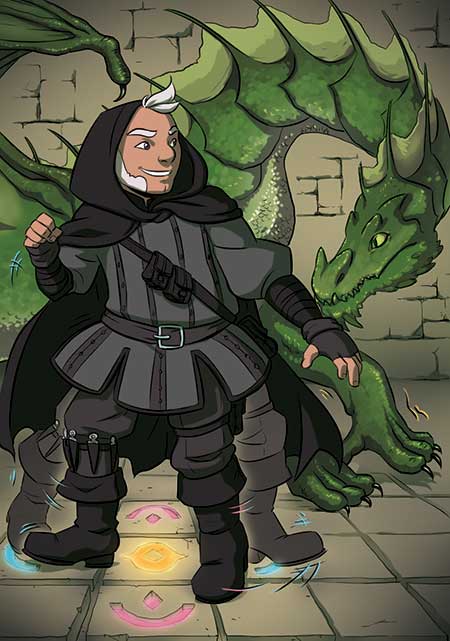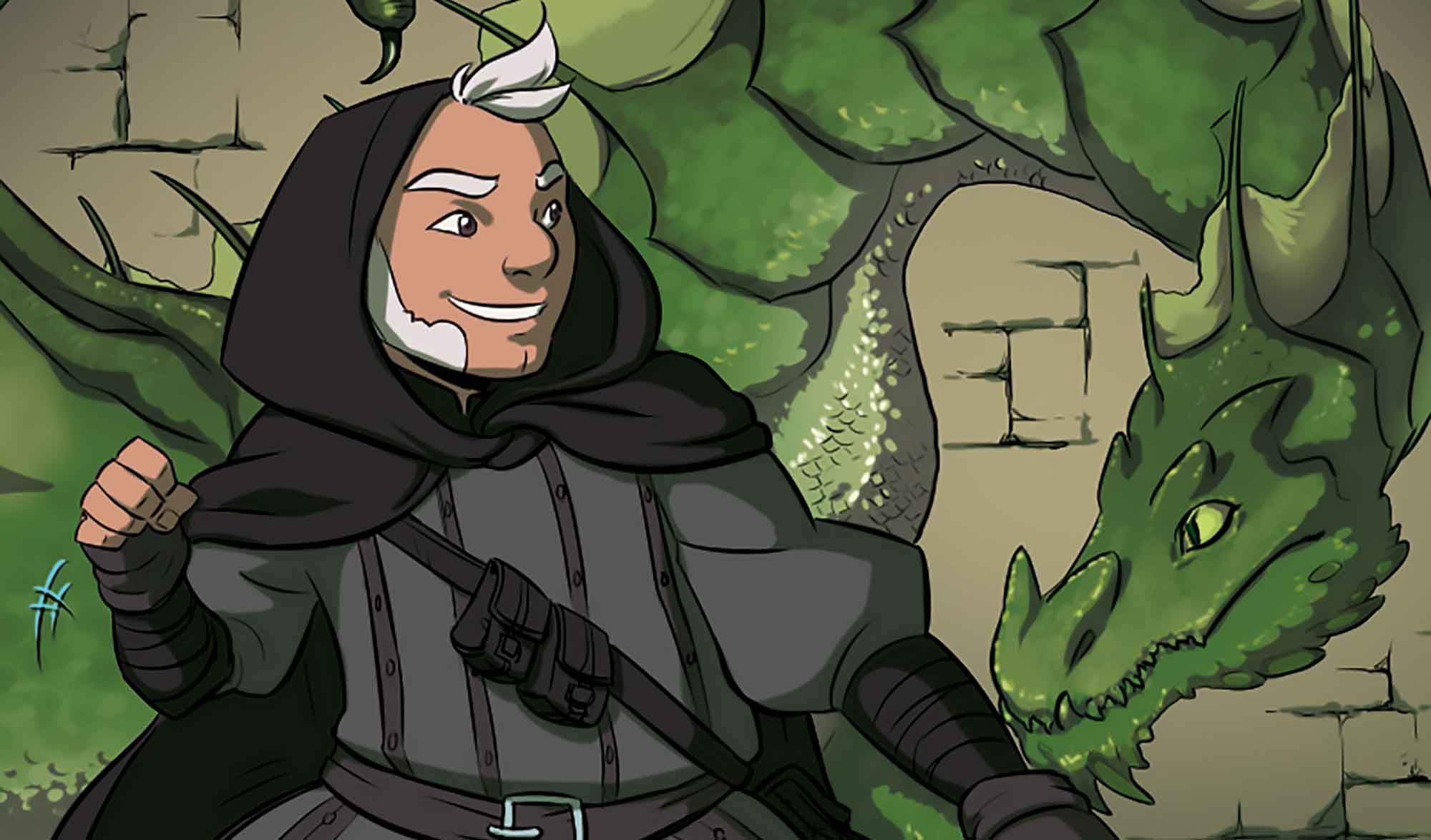Memorable Monsters: Befriending the Monster (in You)
- December 19, 2018
- Articles
- Posted by Jen Vaughn
- Comments Off on Memorable Monsters: Befriending the Monster (in You)
Maybe you’ve never moved cities or states, let alone schools. Consider playing role-playing games as adventuring into a new school with a new set of problems: where to sit at lunch, what after-school activity to sign up for, and whom to sit next to on the bus.
If you were approaching role-playing like a new school, you wouldn’t immediately pull out your sharp ruler and slash someone’s calves, would you? You would try to find a common subject, or in the case, a similar language to speak. Friends or allies can offer you even more than rummaging through the pockets of a swiftly-cooling corpse.
What do friends offer you? They know where the good food is, have great stone collections, and know the good local bands. In tabletop games, they could be NPCs who join the group for a while, guide you to a lucrative side-quest, or help reunite a member of the group with a missing friend. There is no limit to what a friend can do for you, on and off table.
And to be fair, there is a tactical reason to befriend aggressors and adventurers on your own quests: bodies add up. People are going to start looking for you. The easiest way to find an adventuring party is to follow the line of rotting corpses left in their wake. And that doesn’t seem very smart, does it?
TACTICS FOR BEFRIENDING MONSTERS AND OTHER THINGS YOU ENCOUNTER (Also a heads-up for GMs who might not be expecting this. Monsters do not need to dwell in just dungeons, they can be around corners of cities, in the library, at the tavern. Humans aren’t the only ones who reside in cities within the realms.)
 DISARM WITH CHARM: Immediately compliment the approaching party. Is one goblin coming out of the forest wearing a bandana for a local sports team? Is that the most pearl-encrusted sword handle you have ever seen? Make up something or ask the GM to describe something—they’ll play along!
DISARM WITH CHARM: Immediately compliment the approaching party. Is one goblin coming out of the forest wearing a bandana for a local sports team? Is that the most pearl-encrusted sword handle you have ever seen? Make up something or ask the GM to describe something—they’ll play along!
ASK FOR DIRECTIONS: You don’t need to pull out your map—we’re not comparing compass roses, nor do we need directions to the dungeon or tower where you are heading. Ask the giants for the best off-the-beaten-path tavern for nibbles, vittles, and libations. These other adventurers and monsters don’t have to be antagonistic—they could even know of the best fantasy pizza in the realms from working there as a youngling (they still have the oven burn marks on their arms to prove it!).
BE THE INFORMATION DESK: You’ve been walking through this forest or beach for HOURS. Did you just encounter the angriest set of flying snakes behind you? And barely escaped with your lives? Let the lovely owlbears in your life know what’s coming up on their path; maybe you’ll be rewarded for your thoughtfulness.
CHALLENGE THEM TO A DANCE-OFF: If it’s obvious there MUST be a fight of some kind, try turning it into something less contact-heavy by challenging those pesky kobolds to a dance-off, push-up contest, or seeing who can sing high enough to shatter this crystal goblet your thief stole from the last tavern. What do the friends you’re playing with like? Think about that and how you can incorporate it into the fantasy realm.
ASK FOR THE MANAGER: Okay, dear reader, I’m suggesting this almost jokingly but…MAYBE management doesn’t know their employed stirges are looting on the side and harassing you in the forest OR this forest is full of unpaid interns who need someone to help them mobilize against management. You could be the catalyst for change for them.
These tips might also be useful to incorporate into gameplay, as sometimes a long, drawn out combat can become less and less fun. Could your in-game rendition of a pop song stop everyone from fighting? You won’t know until you try.
What does “monster” mean anyway? Something you don’t understand and can’t comprehend. And you can’t learn more if you kill before investigating and asking questions. A monster is a friend you haven’t met yet. Most monsters have unique society standards that can echo in your encounters—a gatherer goblin wouldn’t hurt a fly (or you) compared to the hunter goblins.
Should you and your adventuring party dispense with fighting, remember enemies offer you nothing but anger and the short path to dull weapons. I’m not suggesting you let your character die from kindness when you are up against a gnoll who will not speak to you and is continuously slashing at you. But given good rolls, you can knock others out instead of taking them out. Maybe they’re under a spell you haven’t detected or are acting out of fear for a kidnapped family member. You can always loot their passed-out body to learn more information (and snag a library card for whatever town they’re from—it’s HIGHLY useful).
Or once you have an enemy tied up, you are FREE to question them about the best tavern pizza pies on the Sword Coast.
MONSTER MEDIATION
Maybe your adventuring party is at the right place, right time to see one set of monsters attacking a different species. It’s time to don the helm of mediation (made that one up!) and problem-solve.
- SEPARATE THE GROUPS: You need to get them to stop fighting first or to cool everyone down if they are about to draw weapons. This is best done with the aforementioned tactics, namely jokes to dissolve some of the tension.
In our example, a minotaur keeps stealing pies from a kobold, who puts them outside their cave to cool. - LISTEN TO EACH SIDE: Get each group/person to state why they are upset, from beginning to end if possible. It doesn’t matter who goes first but one monster/person at a time.
Do not let the kobold or minotaur argue or speak over each other. - RESTATE THE CASE AND THE POSITIVES: Sometimes hearing a problem in a third party’s words (someone who has little or nothing to gain from choosing a side) will turn a light on for one of the sides. It’s usually not that easy but it’s fun to dream. Focusing also on any positives is helpful.
Hey, at least the kobold is making GOOD pies, right? The minotaur wouldn’t eat a garbage pie. - FIND THE MIDDLE: In most conflicts, there is a way to compromise. To meet in the middle so everyone leaves smiling, or at least not bleeding, broken, and dead. Does a flying monster keep stealing pies from a local baker? What are some possible solutions? Go ahead and write down three; we can look at them later.*
- FOCUS ON THE FUTURE: This might be the hardest step, but what can the parties involved do differently in the future? Assigning blame won’t necessarily encourage change on the guilty party.
Ready?
*Okay, it’s later. Some options I came up with (maybe yours are similar!):
- Make the minotaur pay for the pies. This is not a great example, despite being simple and logical, because it doesn’t focus on the future. The minotaur might have been raised in an area where things not guarded are up for grabs.
- Have the minotaur supply items to be baked into pies. They can provide items that maybe a kobold would have never seen before!
- Get the kobold and minotaur to go deeper into business together. Turn the minotaur not into a supplier but a partner via a pie delivery service! Now the kobold is making pies for money too!
—
To encourage creativity and thinking outside the box, or in this case outside the dungeon: think monstrous. I’m a big proponent of not playing as a human in role-playing games. We wear so many masks and faces throughout our every day—this is FANTASY. Let’s start with maybe some big lower teeth poking out of our mouth, a set of horns, or glowing eyes. People might treat you differently, you may have to eat food differently, but this will help you adapt to new circumstances (in and out of game).
Let’s be frank—as far as we know, most RPG manuals were written from the point of views of humans, ergo the default point of view IS human. Even if the lands are equally split between humans, elves, orcs, goblins, tieflings, etc., your GM will mostly likely operate under the idea of humans as default. Also, playing as a quote-unquote monster and putting yourself into their shoes (or horns) will give you insight to use when befriending the same species in the future.
Which is why it’s so enriching and narratively fun to play as something else in the manual. I’m partial to demonic monsters like tieflings (basically like gargoyles, born from evil magicks). Sometimes I add a twist playing them as if they’ve escaped the limiting confines and expectations of their species. The play of nature vs nurture is a narrative thread you can all use! Think of if in the “real world” a friend grew up in a meat-eating household but wants to learn more about plant-based diets and experiment with making meals without meat. They are getting to play with their food (har har) and you can do the same at your tabletop game.
For example: Playing as a lizardfolk or dragonborn, you aren’t biologically seeking the same types of things as warm-blooded creatures. You can even play into the ectothermic nature. Ectotherms cannot derive their own body heat and must absorb it from the sun or warm things like fire. During a short rest, you have to sunbathe to keep up your energy. Smack on some personality like dressing and acting in goth fashion (and hating the sun) while being a lizard-person and you have a lot of internal conflict to play with.
A smooth-talking elf will get much further naturally in a conversation with politicians than a ham-and-cheese-fisted orc, unless you pump up the charisma points when you level up. If we made a chart of playable monsters and characters in the game, we’d see all the same personality traits in humans are also in the monsters and vice versa. It is the extremes that traits are pushed to that are the base for said monsters. Or as I like to call them, friends.
 Jen Vaughn dual-classes as both a writer (Goosebumps: Download and Die) and an artist (Teenage Wasteland, many issues of Rolled & Told). When not playing 5th edition, Jen is RECORDING playing D&D with her all-ages podcast, d20 Dames (as a tiefling, of course).
Jen Vaughn dual-classes as both a writer (Goosebumps: Download and Die) and an artist (Teenage Wasteland, many issues of Rolled & Told). When not playing 5th edition, Jen is RECORDING playing D&D with her all-ages podcast, d20 Dames (as a tiefling, of course).


